
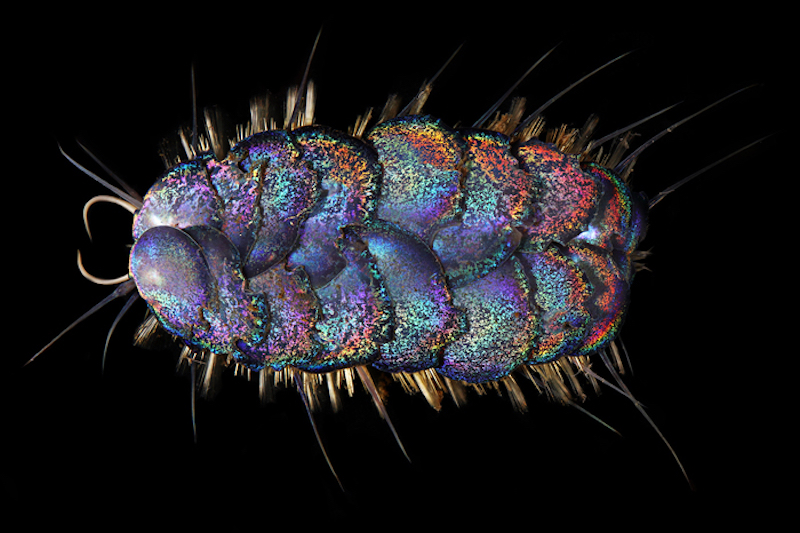
This new species, discoved in 2020, is called the Feisty Elvis Worm. It’s #9 on the list. Image via WoRMS.
On March 19, 2021, the World Register of Marine Species (WoRMS) released its annual list of the top 10 new marine species described by researchers during the year 2020. This year’s list of newly-described ocean species includes the E.T. sponge, fighting Elvis worms, the tiny tree-of-life tardigrade, and the Patrick sea star.
In the opening sequence of the BBC documentary series Blue Planet II, David Attenborough says:
The oceans cover 70% of the surface of our planet, and yet they are still the least explored. Hidden beneath the waves, there are creatures beyond our imagination.
We don’t know how many species exist in the oceans. An incredible number have never been encountered by humans at all. In labs, museums, and out in the out field, taxonomists – scientists who name, describe and classify organisms – are busy collecting, cataloguing, identifying, comparing marine species,including fish, crustaceans, mollusks, corals, sponges, jellies and worms, new to science. The WoRMS top 10 list, selected by taxonomists and science journal editors, is just a small highlight of almost 2,000 fascinating new marine species discovered every year.
Here’s the 2020 list, with the WoRMS descriptions of the species:
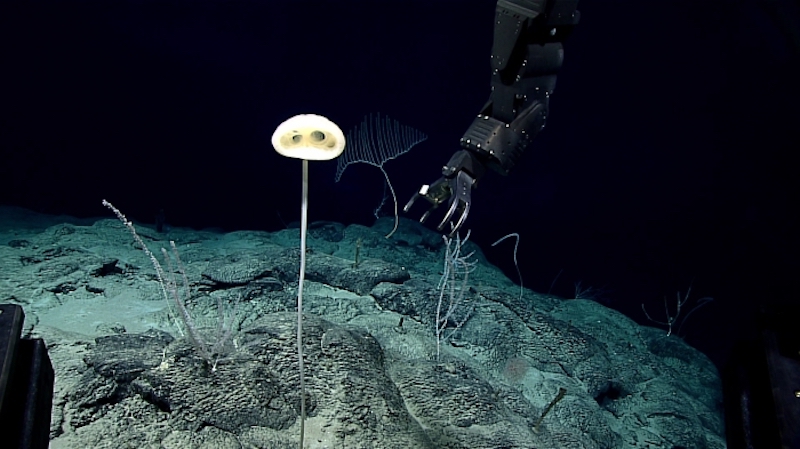
The E.T. Sponge. Image via WoRMS
1. The E.T. Sponge
The E.T. Sponge, Advhena magnifica was spotted by a team of NOAA explorers that were searching the sea floor of the Pacific Ocean. Over 1.25 miles (2 km) below the surface, the explorers were amazed to come across a deep-sea environment studded with strange and beautiful animals that looked more like an alien landscape than something found on Earth. This area was dubbed the Forest of the Weird in reference to many forms of gorgeous, delicate, glass sponges seen growing along the sea floor like an alien forest.
Among these strange glass sponges was the new species Advhena magnifica (Latin for “magnificent alien”). Growing high on its stalk like an elongate mushroom, the sponge is adorned with large openings that face into the current so it can filter small food items from the water. The round body of the sponge with its two openings looking like eye sockets was reminiscent of the head of the alien from the beloved movie E.T. the Extra Terrestrial, and earned this sponge its common name, the E.T. Sponge. Read more.
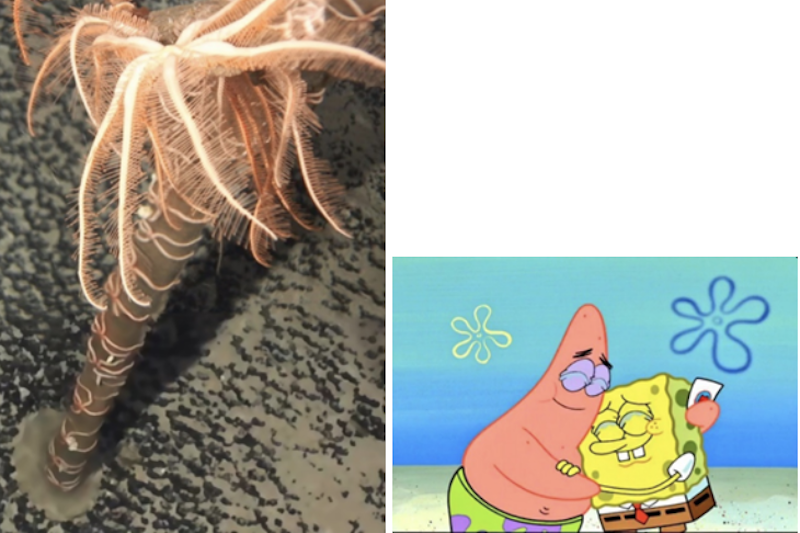
Patrick Sea Star. Image via WoRMS.
2. The Patrick Sea Star
This new species of starfish is named after Patrick Star from the beloved cartoon SpongeBob Squarepants. It was discovered in the depths of the northwestern Pacific Ocean at a few locations 1-2 miles (1.5-3 km) below the surface. It gained its name not from the pink-red color it shares with Patrick Star, but more aptly from its close association with another species – a sponge! All five specimens of the new starfish species were found attached to deep-sea sponges.
In the paper describing this new species, the authors write that the name originated from the character Patrick Star, who always spends time with his best friend SpongeBob, a benthic sponge. Since all specimens of the new species were observed living on sponges, it was named after Patrick to reflect this curious relationship. Read more.

Branch-armed nostril copepod. Image via WoRMS.
3. The Branch-Armed Nostril Copepod
Copepods are small crustaceans that are found in all aquatic habitats, both marine and freshwater. Many copepods are herbivores or predators, but there are also thousands of species of parasitic copepods, like the new species here. Among its parasitic brethren, the Branch-Armed Nostril Copepod, Dendrapta nasicola, is unique in all the ways its name suggests: it has branched, root-like arms (more accurately called maxillae) and it lives in the nostrils of its host, the skate Bathyraja scaphiops. Its highly branched “arms” are modified appendages that this species uses to attach to the inside of the nostril of the skate. Disturbingly, the branched arms grow into the tissue of its host, permanently securing the parasite inside the nostril and making their removal very difficult. Much to the infected host’s chagrin, skates don’t even have a finger to pick their nostrils with! Read more.
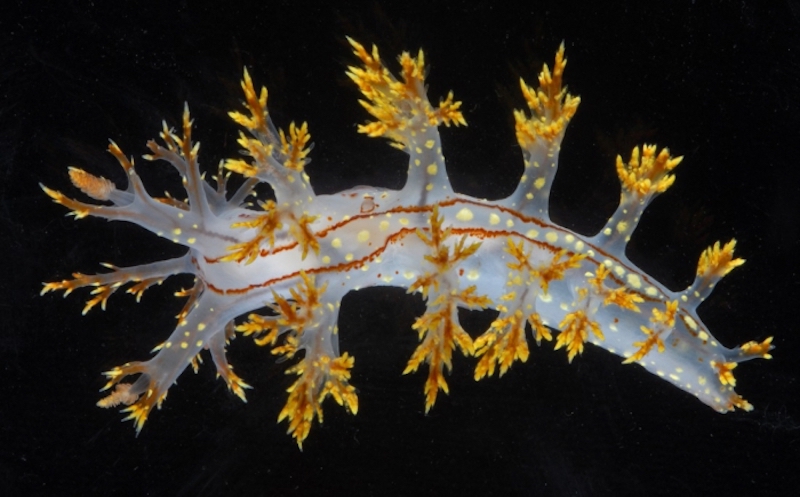
The Yellow Sea Slug of Ørland. Image via WoRMS.
4. The Yellow Sea Slug of Ørland
What do Facebook, scuba divers, and scientists all have in common? They were all instrumental in discovering and describing the Yellow Sea Slug of Ørland! This sea slug was first noticed and photographed in 2014 by scuba diver Kjetil Johnson in Trondheimsfjorden, one of the largest Fjords in Norway. Three years later, another diver, Viktor Grøtan, photographed the animal again. Both divers took to social media and posted their photographs in a Facebook group called NE Atlantic Nudibranchs. After seeing the images from the Facebook group, scientists secured collection permits and asked the divers to collect some of the sea slugs they had photographed. The divers agreed and provided specimens to a team of scientists, and they all worked closely together to describe the new species. Both scuba divers were recognized for their contribution and co-authored the publication with the team of scientists. The new species is named Dendronotus yrjargul in reference to the locality, ‘Yrjar’ which was the old name for Ørland, and ‘gul’ referring to its yellow or golden markings. Read more.
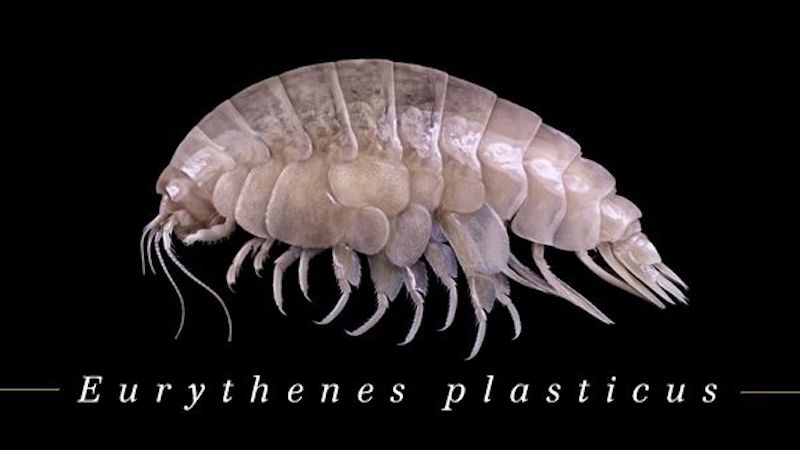
The Giant Plastic Amphipod. Image via WoRMS.
5. The Giant Plastic Amphipod
Describing a new species provides a unique opportunity to capture the minds and hearts of the public and inspire them to become better environmental stewards. One of the many anthropogenic threats facing our ocean is plastic pollution. This year, a new scavenging amphipod crustacean was discovered living 3.75-4 miles (6 to 7 km) below sea level in the Mariana Trench, the deepest place on Earth.
While every new species is an achievement for science, in this case, one of the 11 specimens was found to have microplastic in its digestive tract. That microplastic fiber was 84% similar to PET, the main polymer in plastic bottles. This represents a tragic milestone; the first-time plastic has been documented in a new species. The new species was given the name plasticus to symbolize the ubiquity of marine plastic pollution. Read more.
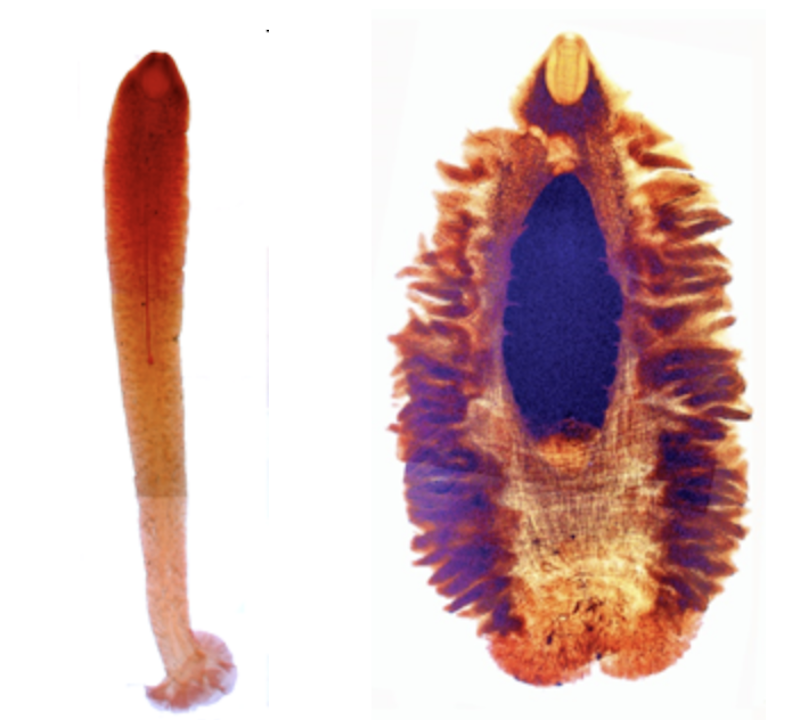
Haffi’s Upside-Down Tapeworm. Left, Holotype (juvenile without frills). Right, Holotype (adult with frills). Image via WoRMS.
6. Haffi’s Upside-Down Tapeworm
Tapeworms are strange yet amazing creatures that have fascinated people for hundreds of years. Just imagine how weird life would be if you had no digestive tract, no stomach or intestine, not even a mouth, yet this is exactly how a tapeworm lives quite happily. Instead of eating their own food, a tapeworm lives in the intestine of another animal and uses its specialized skin to absorb the already digested nutrients from its host.
Even among tapeworms this new species is an oddball. It belongs to the order Gyrocotylidea, a group of just 17 species that are the distant cousins of all other tapeworms. Like a relic from ancient times, these worms are very different from other tapeworms. While all other tapeworms have a specialized attachment structure at their head-end called a scolex, gyrocotylideans have only a simple suction cup structure at that end, but they sport a complex, flower shaped adhesive organ, called a rosette, at their tail. This rosette superficially resembles a scolex, hence the name used here: upside-down tapeworm. Read more.
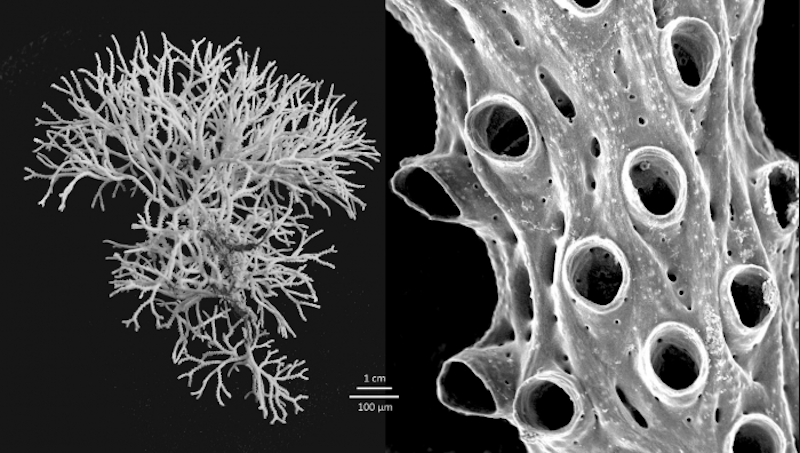
The Beautiful Branching Bryozoan. Image via WoRMS.
7. The Beautiful Branching Bryozoan
Bryozoans are a largely overlooked group of colonial invertebrates that live in aquatic environments worldwide. The colonies of different species are found in a variety of forms, from encrusting types that grow on a substrate such as rock, shells or seaweeds, to those that build exoskeletons resembling corals. This new species is one of the beautiful branching bryozoans and is found in the Mediterranean Sea, perhaps one of the best studied seas in the world. This new species has been overlooked because of problems in the naming of the known species for more than a century. Read more.
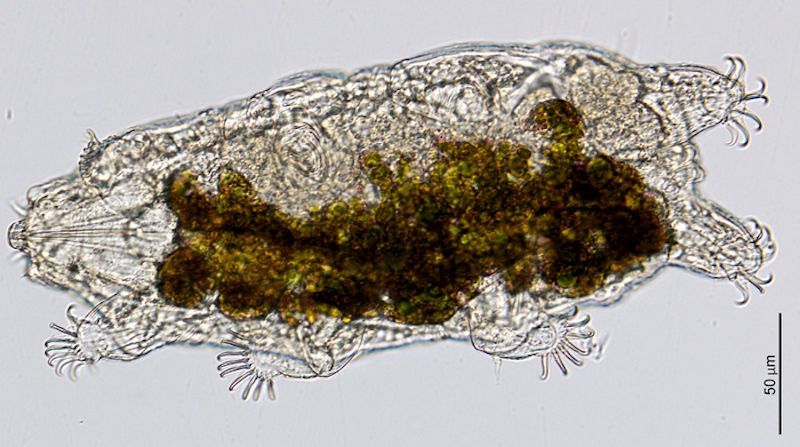
The Tree-of-Life Tardigrade. Image via WoRMS.
8. The Tree-of-Life Tardigrade
Tardigrades, also known as water bears, are a fascinating group of microscopic animals with four pairs of short legs that are famous for their ability to survive extreme conditions of temperature, pressure, starvation and dehydration. The best-known tardigrades are found in terrestrial environments among mosses, but they are found everywhere in the world, from the tops of mountains to the depths of the ocean, and there are many species that live in the marine environment.
This new tardigrade was discovered living in sandy sediments in the intertidal zone of a bay in Roscoff in France that falls dry at low tide. The animal is indeed tiny, at around 1/3 of a millimeter, but for a marine tardigrade it is considered of medium to large size! Read more.
9. The Feisty Elvis Worm
Peinaleopolynoe is a group of remarkable scale worms native to deep-sea chemosynthetic-based ecosystems, including methane seeps, hydrothermal vents, and organic falls (e.g. whale falls). These scale worms have evolved to tolerate low oxygen levels by having elaborate gills under their scales. The authors had for many years nicknamed these sparkly scale worms ‘Elvis worms’ because their scales resembled the sequins on Elvis’ signature attire. We chose one of the species, Peinaleopolynoe orphanae for the Top 10 Marine Species for 2020, as it is perhaps the most exciting of the four new species described in Hatch et al. (2020), having both the most stunning iridescence and the feistiest temperament! Read more.
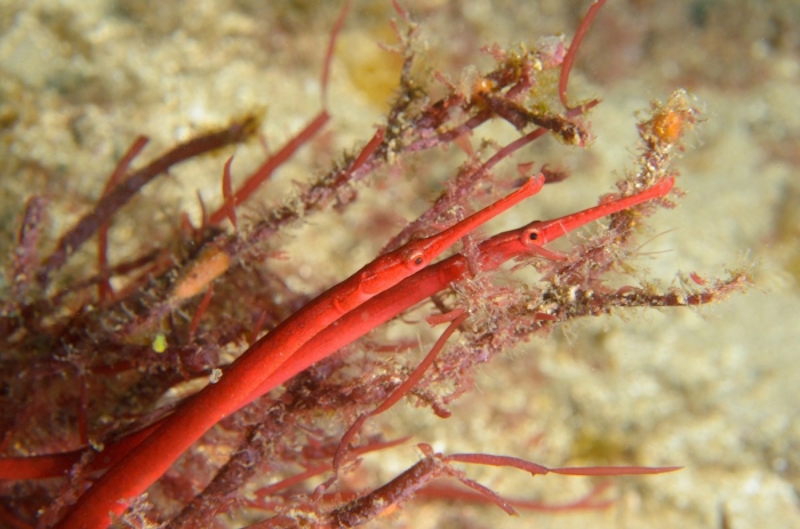
Red Wide-Bodied Pipefish. Image via WoRMS.
10. Red Wide-Bodied Pipefish
This colorful new species of pipefish has been chosen for the top 10 for its clever camouflage, among red algae and sponges, and the fact that it has been described from Sydney’s underwater doorstep, a popular dive site where it has been hiding for years without anyone realizing. The Red Wide-Bodied Pipefish, Stigmatopora harastii is known from central New South Wales, Australia from just three localities, in Botany Bay, Shellharbour, and Jervis Bay, where it occurs in semi-exposed bay entrances and ocean embayments in sandy areas, interspersed amongst rocky reefs at depths between 40-80 feet (12–25 meters). Read more.
Bottom line: A list of 10 ocean species discovered in 2020.
from EarthSky https://ift.tt/2PHehFl


This new species, discoved in 2020, is called the Feisty Elvis Worm. It’s #9 on the list. Image via WoRMS.
On March 19, 2021, the World Register of Marine Species (WoRMS) released its annual list of the top 10 new marine species described by researchers during the year 2020. This year’s list of newly-described ocean species includes the E.T. sponge, fighting Elvis worms, the tiny tree-of-life tardigrade, and the Patrick sea star.
In the opening sequence of the BBC documentary series Blue Planet II, David Attenborough says:
The oceans cover 70% of the surface of our planet, and yet they are still the least explored. Hidden beneath the waves, there are creatures beyond our imagination.
We don’t know how many species exist in the oceans. An incredible number have never been encountered by humans at all. In labs, museums, and out in the out field, taxonomists – scientists who name, describe and classify organisms – are busy collecting, cataloguing, identifying, comparing marine species,including fish, crustaceans, mollusks, corals, sponges, jellies and worms, new to science. The WoRMS top 10 list, selected by taxonomists and science journal editors, is just a small highlight of almost 2,000 fascinating new marine species discovered every year.
Here’s the 2020 list, with the WoRMS descriptions of the species:

The E.T. Sponge. Image via WoRMS
1. The E.T. Sponge
The E.T. Sponge, Advhena magnifica was spotted by a team of NOAA explorers that were searching the sea floor of the Pacific Ocean. Over 1.25 miles (2 km) below the surface, the explorers were amazed to come across a deep-sea environment studded with strange and beautiful animals that looked more like an alien landscape than something found on Earth. This area was dubbed the Forest of the Weird in reference to many forms of gorgeous, delicate, glass sponges seen growing along the sea floor like an alien forest.
Among these strange glass sponges was the new species Advhena magnifica (Latin for “magnificent alien”). Growing high on its stalk like an elongate mushroom, the sponge is adorned with large openings that face into the current so it can filter small food items from the water. The round body of the sponge with its two openings looking like eye sockets was reminiscent of the head of the alien from the beloved movie E.T. the Extra Terrestrial, and earned this sponge its common name, the E.T. Sponge. Read more.

Patrick Sea Star. Image via WoRMS.
2. The Patrick Sea Star
This new species of starfish is named after Patrick Star from the beloved cartoon SpongeBob Squarepants. It was discovered in the depths of the northwestern Pacific Ocean at a few locations 1-2 miles (1.5-3 km) below the surface. It gained its name not from the pink-red color it shares with Patrick Star, but more aptly from its close association with another species – a sponge! All five specimens of the new starfish species were found attached to deep-sea sponges.
In the paper describing this new species, the authors write that the name originated from the character Patrick Star, who always spends time with his best friend SpongeBob, a benthic sponge. Since all specimens of the new species were observed living on sponges, it was named after Patrick to reflect this curious relationship. Read more.

Branch-armed nostril copepod. Image via WoRMS.
3. The Branch-Armed Nostril Copepod
Copepods are small crustaceans that are found in all aquatic habitats, both marine and freshwater. Many copepods are herbivores or predators, but there are also thousands of species of parasitic copepods, like the new species here. Among its parasitic brethren, the Branch-Armed Nostril Copepod, Dendrapta nasicola, is unique in all the ways its name suggests: it has branched, root-like arms (more accurately called maxillae) and it lives in the nostrils of its host, the skate Bathyraja scaphiops. Its highly branched “arms” are modified appendages that this species uses to attach to the inside of the nostril of the skate. Disturbingly, the branched arms grow into the tissue of its host, permanently securing the parasite inside the nostril and making their removal very difficult. Much to the infected host’s chagrin, skates don’t even have a finger to pick their nostrils with! Read more.

The Yellow Sea Slug of Ørland. Image via WoRMS.
4. The Yellow Sea Slug of Ørland
What do Facebook, scuba divers, and scientists all have in common? They were all instrumental in discovering and describing the Yellow Sea Slug of Ørland! This sea slug was first noticed and photographed in 2014 by scuba diver Kjetil Johnson in Trondheimsfjorden, one of the largest Fjords in Norway. Three years later, another diver, Viktor Grøtan, photographed the animal again. Both divers took to social media and posted their photographs in a Facebook group called NE Atlantic Nudibranchs. After seeing the images from the Facebook group, scientists secured collection permits and asked the divers to collect some of the sea slugs they had photographed. The divers agreed and provided specimens to a team of scientists, and they all worked closely together to describe the new species. Both scuba divers were recognized for their contribution and co-authored the publication with the team of scientists. The new species is named Dendronotus yrjargul in reference to the locality, ‘Yrjar’ which was the old name for Ørland, and ‘gul’ referring to its yellow or golden markings. Read more.

The Giant Plastic Amphipod. Image via WoRMS.
5. The Giant Plastic Amphipod
Describing a new species provides a unique opportunity to capture the minds and hearts of the public and inspire them to become better environmental stewards. One of the many anthropogenic threats facing our ocean is plastic pollution. This year, a new scavenging amphipod crustacean was discovered living 3.75-4 miles (6 to 7 km) below sea level in the Mariana Trench, the deepest place on Earth.
While every new species is an achievement for science, in this case, one of the 11 specimens was found to have microplastic in its digestive tract. That microplastic fiber was 84% similar to PET, the main polymer in plastic bottles. This represents a tragic milestone; the first-time plastic has been documented in a new species. The new species was given the name plasticus to symbolize the ubiquity of marine plastic pollution. Read more.

Haffi’s Upside-Down Tapeworm. Left, Holotype (juvenile without frills). Right, Holotype (adult with frills). Image via WoRMS.
6. Haffi’s Upside-Down Tapeworm
Tapeworms are strange yet amazing creatures that have fascinated people for hundreds of years. Just imagine how weird life would be if you had no digestive tract, no stomach or intestine, not even a mouth, yet this is exactly how a tapeworm lives quite happily. Instead of eating their own food, a tapeworm lives in the intestine of another animal and uses its specialized skin to absorb the already digested nutrients from its host.
Even among tapeworms this new species is an oddball. It belongs to the order Gyrocotylidea, a group of just 17 species that are the distant cousins of all other tapeworms. Like a relic from ancient times, these worms are very different from other tapeworms. While all other tapeworms have a specialized attachment structure at their head-end called a scolex, gyrocotylideans have only a simple suction cup structure at that end, but they sport a complex, flower shaped adhesive organ, called a rosette, at their tail. This rosette superficially resembles a scolex, hence the name used here: upside-down tapeworm. Read more.

The Beautiful Branching Bryozoan. Image via WoRMS.
7. The Beautiful Branching Bryozoan
Bryozoans are a largely overlooked group of colonial invertebrates that live in aquatic environments worldwide. The colonies of different species are found in a variety of forms, from encrusting types that grow on a substrate such as rock, shells or seaweeds, to those that build exoskeletons resembling corals. This new species is one of the beautiful branching bryozoans and is found in the Mediterranean Sea, perhaps one of the best studied seas in the world. This new species has been overlooked because of problems in the naming of the known species for more than a century. Read more.

The Tree-of-Life Tardigrade. Image via WoRMS.
8. The Tree-of-Life Tardigrade
Tardigrades, also known as water bears, are a fascinating group of microscopic animals with four pairs of short legs that are famous for their ability to survive extreme conditions of temperature, pressure, starvation and dehydration. The best-known tardigrades are found in terrestrial environments among mosses, but they are found everywhere in the world, from the tops of mountains to the depths of the ocean, and there are many species that live in the marine environment.
This new tardigrade was discovered living in sandy sediments in the intertidal zone of a bay in Roscoff in France that falls dry at low tide. The animal is indeed tiny, at around 1/3 of a millimeter, but for a marine tardigrade it is considered of medium to large size! Read more.
9. The Feisty Elvis Worm
Peinaleopolynoe is a group of remarkable scale worms native to deep-sea chemosynthetic-based ecosystems, including methane seeps, hydrothermal vents, and organic falls (e.g. whale falls). These scale worms have evolved to tolerate low oxygen levels by having elaborate gills under their scales. The authors had for many years nicknamed these sparkly scale worms ‘Elvis worms’ because their scales resembled the sequins on Elvis’ signature attire. We chose one of the species, Peinaleopolynoe orphanae for the Top 10 Marine Species for 2020, as it is perhaps the most exciting of the four new species described in Hatch et al. (2020), having both the most stunning iridescence and the feistiest temperament! Read more.

Red Wide-Bodied Pipefish. Image via WoRMS.
10. Red Wide-Bodied Pipefish
This colorful new species of pipefish has been chosen for the top 10 for its clever camouflage, among red algae and sponges, and the fact that it has been described from Sydney’s underwater doorstep, a popular dive site where it has been hiding for years without anyone realizing. The Red Wide-Bodied Pipefish, Stigmatopora harastii is known from central New South Wales, Australia from just three localities, in Botany Bay, Shellharbour, and Jervis Bay, where it occurs in semi-exposed bay entrances and ocean embayments in sandy areas, interspersed amongst rocky reefs at depths between 40-80 feet (12–25 meters). Read more.
Bottom line: A list of 10 ocean species discovered in 2020.
from EarthSky https://ift.tt/2PHehFl

Aucun commentaire:
Enregistrer un commentaire